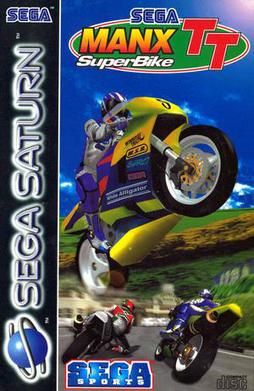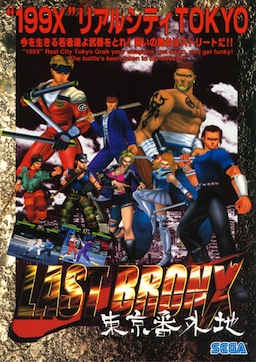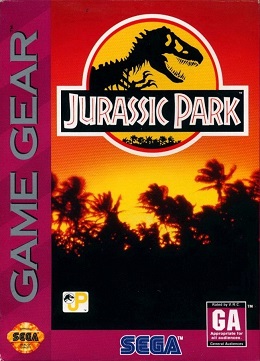
Virtua Cop is a 1994 light gun shooter game developed by Sega AM2 and designed by Yu Suzuki. It was originally an arcade game on the Sega Model 2 system, and was ported to the Sega Saturn in 1995 and Windows in 1996. The Saturn version included support for both the Virtua Gun and Saturn mouse, as well as a new "Training Mode" which consists of a randomly generated shooting gallery.

The House of the Dead is a 1996 horror-themed light gun shooter arcade game developed by Sega AM1 and released by Sega. It is the first game in the House of the Dead series. Players assume the role of agents Thomas Rogan and "G" as they combat an army of undead experiments created by Dr. Curien, a mad scientist.

Sega Rally Championship is a 1994 racing game developed by Sega AM3 and published by Sega. Originally released for arcades using the Sega Model 2 board, ports were published for the Sega Saturn in 1995 and Microsoft Windows in 1997. Sega Rally Championship simulates driving on different surfaces, with different friction properties, with the car's handling changing accordingly. As the first racing game to incorporate this feature, Sega Rally Championship is considered to be one of the milestones in the evolution of the racing game genre. It was also an early rally racing game and featured cooperative gameplay alongside the usual competitive multiplayer.

X-Men: Children of the Atom is an arcade game that was produced by Capcom and released on the CP System II arcade hardware in 1994 in Japan and in 1995 in North America and Europe.

Sega AM Research & Development No. 3, known as Hitmaker Co., Ltd. from 2000 to 2004, is a defunct division of Sega, a Japanese video game company. Established by 1993, AM3 was managed by Hisao Oguchi and developed a number of arcade games for Sega. Series introduced by AM3 include Virtual On, Sega Rally, Crazy Taxi, and Virtua Tennis. AM3's main focus was on arcade games until the release of the Dreamcast. Additionally, developers Tetsuya Mizuguchi and Kenji Sasaki developed Sega Rally Championship with AM3 before departing to form AM Annex, which later split into Sega AM9 and Sega AM5.

Numerous video games based on the Jurassic Park franchise have been released. Developers Ocean Software, BlueSky Software and Sega produced various games in 1993, coinciding with the first film, Jurassic Park. In 1997, several developers, including DreamWorks Interactive and Appaloosa Interactive, produced various games for nine different platforms to coincide with the release of the film The Lost World: Jurassic Park.

Die Hard Arcade, known as Dynamite Deka in Japan, is an arcade beat 'em up video game released by Sega. It was the first beat 'em up to use texture-mapped 3D polygon graphics, and used a sophisticated move set by contemporary beat 'em up standards, often being likened to a fighting game in this respect. It also features quick time events, the ability to combine items to make more powerful weapons, and in two-player mode the ability to perform combined special moves and combos.

Virtua Fighter 2 is a 1994 fighting video game developed by Sega. It is the sequel to Virtua Fighter (1993), and the second game in the Virtua Fighter series. It was created by Sega's Yu Suzuki-headed AM2 and was released for arcades in 1994. Ports were released for the Sega Saturn in 1995 and Microsoft Windows in 1997.

The Lost World: Jurassic Park is an action-adventure video game developed by DreamWorks Interactive and Appaloosa Interactive, and published by Electronic Arts and Sega for the Sony PlayStation and Sega Saturn, respectively, in 1997. The Lost World: Jurassic Park is based on the film of the same name, which in turn is based on the novel by Michael Crichton. In 1998, a special edition of the game was released for the Sony PlayStation as a Greatest Hits title and featured several modifications to the gameplay.
Jurassic Park is a rail shooter arcade game developed and released by Sega in 1994. It is based on the 1993 film of the same name. The game cabinet resembles the rear of the first-gen Ford Explorer XLT tour vehicles used in the film. The player(s), equipped with the joystick(s), must shoot dinosaurs that appear on-screen throughout the game.

Rad Mobile is a racing arcade game developed by Sega AM3 and published by Sega. It was first published in Japan in October 1990, followed by an international release for arcades in February 1991. Rad Mobile was Sega's first 32-bit game, using Sega's System 32 arcade system board. It was also the first appearance of Sonic the Hedgehog, who appears as an ornament hanging from the driver's rearview mirror.

Sega Touring Car Championship is an arcade racing game released by Sega's AM Annex for the Model 2 mainboard in 1996. It was later ported to the Sega Saturn and Microsoft Windows.

Manx TT Super Bike is a 1995 arcade racing game developed jointly by Sega AM3 and Sega-AM4. It is a motorcycle racing game built for the Sega Model 2 arcade board. Up to 8 players can race in this game if enough arcade cabinets are linked together, following on from Daytona USA. It was later ported to the Sega Saturn by Tantalus Interactive and to Windows by Perfect Entertainment.

Last Bronx is a 3D fighting video game developed by Sega AM3 on the Sega Model 2 mainboard. It was released in Japanese game centers in 1996. Home versions of Last Bronx were produced for the contemporary Sega Saturn and Windows systems. In Japan, Last Bronx was novelized and serialized into comics and radio drama. A VHS video documenting the motion capture process used for the game and introducing the characters was released in 1996. A year later, Takashi Shimizu directed the live-action movie (V-Cinema). On June 29, 2006, Sega released Last Bronx on PlayStation 2 as a tenth anniversary celebration.

Daytona USA: Championship Circuit Edition, or Daytona USA: Circuit Edition in Japan, is a racing game by Sega, specifically designed for the Sega Saturn. Released in 1996, it is a reworked and extended version of the original Daytona USA, and was developed by Sega AM3, the same team that oversaw the Saturn port of Sega Rally Championship, by using a modified version of the Sega Saturn engine of Sega Rally Championship.

Top Skater is an arcade skateboarding sports video game released by Sega in 1997, and built on the Sega Model 2 hardware. It was one of the first arcade games to feature a skateboard controller interface. The game was directed by Kenji Kanno.

The Lost World: Jurassic Park is the title of several different video games released for handheld video game consoles in 1997. Four versions, each with their own gameplay variations, were developed and published by various companies for the Sega Game Gear, Nintendo's Game Boy, and Tiger Electronics' game.com and R-Zone consoles. Each version is based on the 1997 film of the same name.

DecAthlete, released in Europe as Athlete Kings due to a licensing issue, is a track-and-field themed arcade sports video game. On its unveiling, the gaming media generally described it as a modern clone of Daley Thompson's Decathlon. Released in 1996, it was developed by Sega AM3 and produced by Sega. A home port was released on the Sega Saturn in 1996, largely identical to the arcade version, due to the similar hardware of the ST-V hardware and the Saturn. It was released on the PlayStation 2 in Japan only as part of the Sega Ages 2500 series. Compared to other decathlon based games, Decathlete has a more comic and cartoon-like style. A sequel followed in 1997, which was the winter sports-based Winter Heat.

The Lost World: Jurassic Park is an action-adventure video game developed by Appaloosa Interactive, and published by Sega for the Sega Genesis. It was released on September 16, 1997. By this time the Genesis was near the end of its commercial lifespan, and months went by between new software releases for the console.

Jurassic Park is a 1993 platform game developed and published by Sega for the Game Gear. Another version, with identical gameplay, was also released for the Master System. The game is based on the 1993 film of the same name. It was praised for its graphics, but criticized for its short length and easy gameplay.


















